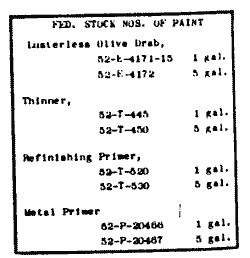
Two extremely ugly individuals from the Chemistry Dep’t stepped into the office yesterday with the request that we run a little something on “The Importance Of, and How To Mix Paint.”
Seems that some of the boys in the field have been hollering bloody murder over the way lustreless olive-drab enamel and metal primer (see box below for Fed. Stock Nos.) settle down and pack in the bottom of the cans.
The reasons and the answers to the reasons are simple to the point of being ridiculous. 1) These paints are highly pigmented and the heavy color matter tends to “settle out”, and deposit on the bottom; 2) Many depots and shops have the had habit of always using the cans of paint off thc top of the heap. The cans at the bottom of the heap grow old in storage and the paint in them settles down to a rock-like consistency. One day. some fool gets one of the old cans and has as much trouble mixing the paint as a guy trying to dissolve a billiard ball in a pail of water.
The thing for shops and depots (in filling requisitions) to do is keep drawing the paint cans off the bottom so that no can will ever grow old in storage.
Anyway, enough foolishness, here’s the proper way to mix paint: First, before mixing the paint should have been stored in a room at a temperature between 65°(F)and 70°(F) so that the paint is at this temperature when mixed. Just like oil, paint thickens in the cold.
If you have a paint mixing machine (base shops are the only place we’ve ever seen them) everything will be jake. Just place the can in the shaker upside down and let it shake for ten minutes.
If the only paint-mixing machine you have is Pfc. Murphy equipped with a small paddle, have Murphy pour off the liquid that is on top of the freshly opened can, into a mixing pot. (You ought to have a couple of five gallon solvent cans with the tops cut out and with handles attached to serve as mixing cans.) Then have your man Murphy mix the settled pigments thoroughly with the paddle to a creamy consistency, slowly pouring back the liquid portion of the paint in small portions, stirring each portion in thoroughly. Finally – and this takes real skill – have Murphy pour the paint back and forth from one can to the other to assure a complete mix.

Although it may take from 30 minutes to an hour to get the paint well mixed — in exceptionally bad cases — it’s time well spent and is really the prime factor in determining whether your paint job is going to be any good or not.
Although olive-drab enamel or metal primer is supplied ready to brush, you may have to use up to 1/2 pint of thinner (See box for Fed. Stock No.) per gallon to get it to the proper consistency. For spraying, thin your paint with 1 1/2 pints of thinner to each gallon of paint.
Funny thing about paint: every new batch you mix up comes out a slightly different shade. Nobody knows why, but since it does, the best way is to mix up enough paint in any one batch to take care of an entire vehicle.
Answering the complaint of those who say they get a streaky, mottled effect in repainting over an old painted surface (in good condition), the Chemistry Dep’t strongly advises — as a matter of fact, they insist — that a coat of “Refinishing Primer” (see box for Fed. Stock No.) be applied to the old painted surface before lustreless olive-drab is put on. The old O.D. paint is porous and rough and won’t let the new paint flow on easily. The result is a paint job liberally mottled and streaked.
To close the painting lesson for today, we’d like to tell you of a little incident — or rather series of incidents — that happened in a certain shop whose name is non-essential. Seems that complaints were continually coming in from non-essential to the effect that there was something in the Army’s paints that was making the painters sick. Painters were reported dropping like flies.
When enough painters had dropped to make the situation urgent, a master mind was dispatched from the Holabird Chemistry Dept to see what the hell was going on.
What he found was that the paint shop of this certain camp was a small closed building well-protected against the entry of fresh air. The effect on painters working in this building was the same as the effect of rich, rare Havana perfectos on ambitious small boys.
Moral: Ventilate your paint shop — not only to protect painters but also so that the paint will dry properly on your trucks. Besides keeping it well-ventilated, keep your paint shop clean. There’s a definite danger of fire by spontaneous combustion in scraps of paint-snaked rags or in accumulations of spray dust in nooks and crannies (see box for Fed. Stock Nos.).
SPECIAL OFFER
The Holabird Chemistry Dep’t, which was largely responsible for the development of a good many of the Army’s paints considers itself admirably equipped to answer any and all questions on paints and their application. Anybody who would like to argue this point is invited to submit questions.
From Army Motors, Vol 3, page 339.
